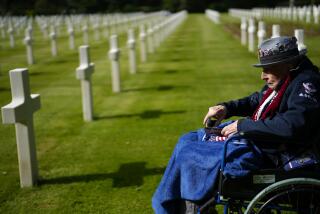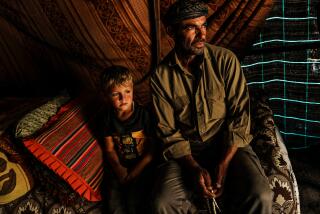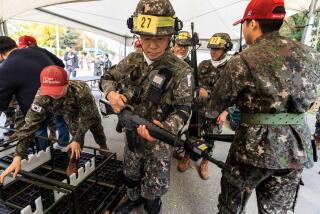After Year, Army Stevedores Ready to Ship Out of Gulf : War aftermath: They were among the first U.S. troops to arrive in the crisis. Now, they’re among the last to leave.
DAMMAM, Saudi Arabia — Deep in the grimy, sweltering belly of the Cape Gibson, a rusty Navy reserve fleet cargo ship only a few months out of mothballs, three Army enlisted men struggled to position a flatbed truck trailer as an operator lowered it into the hold with a port-side gantry crane.
It was stevedores’ work that the men and women of the 7th Transportation Group had been doing nonstop since Aug. 11 last year, when they were among the first American troops to arrive in Saudi Arabia. Eight hundred ships later--after handling 240,000 vehicles, 1,850 helicopters and 300,000 tons of ammunition--they were working on their last load.
Now, in “three days and a wake-up,” these 2,500 stevedores from Ft. Eustis, Va., will be among the last out. Compared to them, most of the 20,000 other U.S. troops still on the ground in Saudi Arabia and Kuwait are recent arrivals.
As usual, the work down in the Cape Gibson’s hold was not simple. The flatbed trailer was missing two wheels and could not be rolled. Placing it securely in the hold depended once again on the strong backs of the Army stevedores--the troops that Army Lt. Gen. Gus Pagonis, commander of U.S. forces remaining here, called “the unsung heroes of the war in the Gulf.”
Standing shoulder to shoulder, they leaned against the trailer as it dangled from a steel cable to guide it to a corner parking spot. A few months before, a similar trailer had broken from its line and smashed into the hold of another ship, barely missing several men.
Far from the most elite of the American forces, the stevedores had watched with sadness and a certain feeling of invisibility as the Armed Forces Television Network here broadcast the big patriotic parades in New York, Washington and other cities for the returning combat troops.
Most of the soldiers feted in those events had served in the Persian Gulf only six months. The stevedores had been here nearly a year. They are leaving because Pagonis has put an absolute cap of one year on those serving in the region. Some of the reservists in the group, facing unemployment or uncertain job prospects back home, had even offered to stay on despite the 120-degree temperatures in the Eastern Province of Saudi Arabia.
Several, such as Army Pfc. Darnell Taylor, 20, one of the broad-shouldered trio in the belly of the Cape Gibson at its berth in the port of Dammam, have children they have never seen, born in their absence. His partner, Spec. Jeffrey Corl, 26, has a son who has doubled in age and learned to walk while he was away.
“He was just shy of 11 months when I left,” said Corl, from Buffalo, N.Y. “That’s the hardest part--being away from the family so long.”
Watching the patriotic parades back home was especially tough for these weary soldiers.
“Most of the guys here were heartbroken. They wanted to be back for the parades,” said Sgt. Fred Burdette, 27. “Some of them came to work the next day with an attitude. They felt they weren’t part of it, and it got them down.”
In their last days of loading ships, the stevedores have been especially careful. During the entire war effort, in which they worked in 12-hour shifts with no days off, the units escaped with only a few serious injuries and no deaths. Their safety record has been better than that of the peacetime longshoremen’s union in New York harbor, the officers here claim.
But there was a palpable feeling of tension, and even a touch of superstition, as the war-worn Army vehicles were secured for the long ride home.
“No matter what you plan,” said Lt. Charles Strang, 24, a choirboy-visaged junior officer from upstate New York, “the last ship is always one of the worst. You have no choice but to take the dead, damaged and broken equipment. You push it, shove it, jam it and do whatever you have to do to get it on board.”
Strang was supervising the loading of what the stevedores call a “RO-RO” ship--a big freighter with an opening in its bow that allows equipment, when it is working, to be driven (“rolled on, rolled off”) into the holds. One of the equipment drivers, Pfc. Scott Engle, 20, of Seattle, figured he had done his part to win the war.
“We did all the dirty work, and the other guys got the press,” he said. “It was kind of frustrating sometimes to see all the parades. We were here longer, but they put their lives on the line. I figure it worked out about even. There were 540,000 soldiers in the war. I was one of them. Not many people can say that.”
Pagonis, the army’s top logistics specialist, has promised a “super parade” for the stevedores sometime next week when they are reunited with their families in Newport News, Va.
During the days of the nationally televised welcome-home parades, the general assembled the stevedores in a warehouse and told them that historians would remember them for their remarkable work getting the tanks and trucks to the glory units of the army.
But for most of the stevedores, talk of history had a hollow ring. By now, the anonymous and backstage role played by the “first-in-last-outers” of this war and all wars had been noted by the men and women of the 7th Transport Group. As the old joke about the Vietnam War had it, they would turn out the lights when they left.
“Even the rest of the Army doesn’t know we exist,” said Lt. Barry Hintz, 24, platoon commander of the Cape Gibson reloading effort. “They say, ‘What are you guys, something to do with the Navy?’ ”
More to Read
Sign up for Essential California
The most important California stories and recommendations in your inbox every morning.
You may occasionally receive promotional content from the Los Angeles Times.










